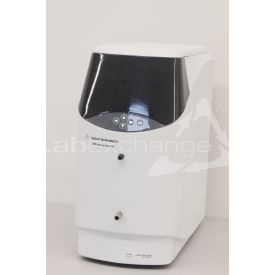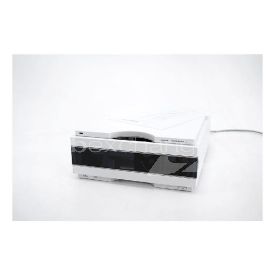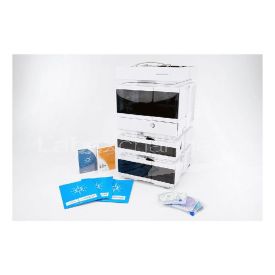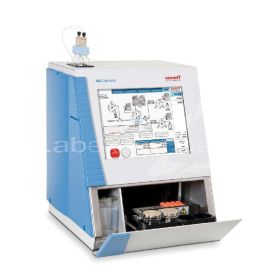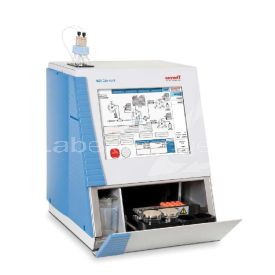manufacturer: Agilent
model: 1200
annotation: Dokumente engl.
The following illustrations and descriptions refer to the instrument model and are drawn from brochures. They do not represent the scope of delivery. Please refer to the text of the offer for the exact scope of delivery.
Because this is a modular system, only an example of a possible configuration is shown!
Agilent 1100 Series Nano pump
Performance Specification
Hydraulic system
Two dual piston in series, with proprietary servo-controlled variable stroke drive, floating piston, active inlet valve, solvent selection valve and electronic flow control for flow rates from 0.1 to 1 μl/min
Settable column flow range
0.01 – 4 μl/min
1 – 2500 μl/min (with the electronic flow control bypassed)
Recommended column flow range
0.1 – 1 μl/min
200 – 2500 μl/min (with the electronic flow sensor bypassed)
Optimum composition range
1 to 99% or 5 μl/min per channel (primary flow), whatever is greater
Composition precision
< 0.2 % SD, at 500 nl/min (default settings),
Minimum primary flow/pump channel is 5 μl/min
Delay volume
Typically 300 nl from the electronic flow control to the pump outlet for
flow rates up to 4 μl/min. For flow rates up to 4 μl/min and electronic
flow control active: primary flow path 180 - 480 μl; system pressure
dependent (default settings; calculated volume)
Typically 180 to 480 μl (system pressure dependent) for flow rates up to
2.5 ml/min. (default settings; calculated volume)
Pressure range
20 to 400 bar (5880 psi) system pressure
Compressibility compensation
User-selectable, based on mobile phase compressibility
Recommended pH range
1.0 – 8.5, solvents with pH < 2.3 should not contain acids which attack
stainless steel. Upper pH range is limited by fused silica capillaries.
Control and data evaluation
Agilent ChemStation for LC
Analog output
For pressure monitoring, 2 mV/bar, one output
Communications
Controller-area network (CAN), GPIB, RS-232C, APG Remote: ready, start, stop and shut-down signals, LAN optional
Safety and maintenance
Extensive diagnostics, error detection and display (through control module and Agilent ChemStation), leak detection, safe leak handling, leak output signal for shutdown of pumping system. Low voltages in major maintenance areas.
GLP features
Early maintenance feedback (EMF) for continuous tracking of instrument usage in terms of seal wear and volume of pumped mobile phase with user-settable limits and feedback messages. Electronic records of maintenance and errors.
Housing
All materials recyclable.
Agilent 1100 Series Micro Degasser
Performance Specification
Maximum flow rate
5 ml/min per channel
Number of channels
4
Internal volume
Typically 1 ml per channel
Internal design
One chamber per channel with optimized flow path for fastest solvent change over
Material in contact with solvents
PTFE, FEP, PEEK
Agilent 1260 Infinity Micro degasser
Physical Specifications
Weight
7 kg (16 lbs)
Dimensions (height × width × depth)
345 x 435 x 80 mm (13.5 x 17 x 3.1 inches)
Line voltage
100 – 240 VAC, ± 10%
Wide-ranging capability
Line frequency
50 or 60 Hz, ± 5%
Power consumption
30 VA / 30 W / 102 BTU
Maximum
Ambient operating temperature
0 – 45 °C (32 – 113 °F)
Ambient non-operating temperature
-40–70 °C (-4–158 °F)
Humidity
< 95%, at 25–40 °C (77–104 °F)
Non-condensing
Operating Altitude
Up to 2000 m (6562 ft)
Non-operating altitude
Up to 4600 m (15091 ft)
For storing the module
Safety standards: IEC, CSA, UL
Installation Category II, Pollution Degree 2
For indoor use only.
1 This temperature range represents the technical specifications for this instrument. The mentioned temperatures may not be suitable for all applications and all types of solvents.
Performance Specifications Agilent 1260 Infinity Vacuum Degasser
Maximum flow rate
0 - 5 ml/min per channel
Number of channels
4
Internal volume per channel
Typically 1 ml per channel
Materials in contact with solvent
PTFE, FEP,PEEK
pH range
1 – 14
RS-232
output For diagnostic purposes
Agilent 1260 Infinity HPLC-Chip cube Interface (G4240A)
The HPLC-Chip MS Interface is comprised of the following parts:
- the HPLC-Chip Cube MS Interface (often referred to as Chip Cube)
- the video monitor
- the Chip Cube Interface Assembly (also referred to as Spray Chamber).
The HPLC-Chip Cube MS Interface
The Chip Cube belongs to the Agilent 1260 Infinity HPLC family. It interfaces the HPLC-Chip to the pump and the μ-well-plate sampler of the nano-LC system. The Chip Cube is connected to the other Agilent 1260 Infinity modules via CAN bus.
The main functions are:
- Connect the HPLC-Chip automatically to solvent lines and grounding contact.
- Extract the sprayer tip from the chip holder.
- Position the sprayer tip reproducible in front of the MS inlet.
- Provide two independent, concentrically high pressure nano flow valves.
Agilent Ion Trap Mass Spectrometer
Mass range, mass resolution and scan speed XCT Ultra
Mass range Resolution Scan speed*
m/z FWHM (u) (u/sec)
----------------------------------------------------------------------------------------
50 - 2200 standard ≤ 0.6 26,000
enhaced ≤ 0.35 8,100
maximum ≤ 0.25 800
200 – 4000 normal ≤ 3 27,000
(extended)
*Total scan cycle time for the XCT Ultra :
The total scan cycle time for the XCT Ultra is approximately 1/3 the scan cycle time of the XCT and XCT Plus, allowing the XCT Ultra to perform 3X as many scans at the same nominal scan speed.
- XCT Ultra standard cycle time: 920 msec - all ions (m/z 50-2200, 3 precursors per cycle.)
- Agilent Peptide Scan: 1065 msec - prefer or only select +2 charge ions (m/z 50-2200, 3 precursors per cycle.)
Mass Accuracy
±0.2 u within the calibrated standard mass range at normal resolution in full scan mode, with proper calibration, ICC target and ion statistics, and thermal equilibrium of electronics and ion source.
Mass Axis Stability
Within ±0.2 u of the observed calibrated value over 8 hours in standard mass range at normal resolution in full scan mode, with proper ICC target and ion statistics, and thermal equilibrium of electronics and ion source and ambient temperature of 21°C ± 3°C (70°F ± 6°F).
Monoisotopic Precursor Selection
Monoisotopic precursor selection is possible throughout the standard mass range (m/z 50 - 2200) at an ambient temperature of 21°C ± 3°C (70°F ± 6°F).
Polarity Switching
XCT Ultra ≈ 0.5 seconds
Sensitivity Specifications
Conditions: Column – ZORBAX Rapid Resolution SB-C18 2.1×30 mm 3.5 micron, Mobile Phase – 25% water 75% methanol 5 mM ammonium acetate, Flow rate – 400 μl/min (200 μl/min for XCT), Mode – full scan MS/MS, MS/MS – transition of the protonated molecular ion (m/z 609) to the sum of the two most abundant product ions. Product ion scan range – m/z 175 – 650, Mass range – standard (m/z 50 - 2200), Resolution – normal/ultrascan (0.6 amu)
XCT Ultra: 250fg (reserpine on column) / Signal to noise ratio (full scan MS/MS): ≥ 50:1
Ion-trap Dimensions
Agilent G2445 Mainframe
Weight: 80 kg
Height: 55.2 cm
Depth: 69.6 cm
Width: 75.4 cm
Mechanical pump:
Weight: 32 kg
Height: 23 cm
Depth: 51 cm
Width: 17 cm
Agilent G1376A Capillary Pump
Performance Specifications
Hydraulic system
Two dual piston in series, with proprietary servo-controlled variable stroke drive, floating piston, active inlet valve, solvent selection valve and electronic flow control for flow rates up to 100 μl/min
Settable column flow range
0.01 – 20 μl/min
0.01 – 100 μl/min (with the extended flow range kit)
0.001 – 2.5 μl/min (with the electronic flow control bypassed)
Recommended column flow range
1 – 20 μl/min
10 – 100 μl/min (with extended flow range kit)
0.1 – 2.5 ml/min (with the electronic flow sensor bypassed)
Column flow precision
< 0.7 % RSD or 0.03 % SD (typically 0.4 % RSD or 0.02 % SD), at 10 μl/min and 50 μl/min column flow (based on RT, default setting)
Optimum composition range
1 to 99% or 5 μl/min per channel (primary flow), whatever is greater
Composition precision
< 0.2 % SD, at 10 μl/min (20 μl flow sensor), 50 μl/min (100 μl flow sensor) and 1 ml/min (normal mode) default setting
Delay volume
Typically 3 μl from the electronic flow control to the pump outlet for flow rates up to 20 μl/min.
Typically 12 μl from the electronic flow control to the pump outlet for flow rates up to 100 μl.
For flow rates up to 100 μl/min and electronic flow control active:
primary flow path 180 - 480 μl without mixer, 600 - 900 μl with mixer
(system pressure dependant)
Typically 180 to 480 μl (system pressure dependent) without mixer for flow rates up to 2.5 ml/min. (Mixer delay volume 420 μl)
Pressure range
20 to 400 bar (5880 psi) system pressure
Compressibility compensation
User-selectable, based on mobile phase compressibility
Recommended pH range
1.0 – 8.5, solvents with pH < 2.3 should not contain acids which attack stainless steel. Upper pH range is limited by fused silica capillaries
Control and data evaluation
Agilent ChemStation for LC
Analog output
For pressure monitoring, 2 mV/bar, one output
Communications
Controller-area network (CAN), GPIB, RS-232C, APG Remote: ready, start, stop and shut-down signals, LAN optional
Safety and maintenance
Extensive diagnostics, error detection and display (through instant pilot and Agilent ChemStation), leak detection, safe leak handling, leak output signal for shutdown of pumping system. Low voltages in major maintenance areas.
GLP features
Early maintenance feedback (EMF) for continuous tracking of instrument usage in terms of seal wear and volume of pumped mobile phase with user-settable limits and feedback messages. Electronic records of maintenance and errors.
Housing
All materials recyclable
Physical Specifications
Weight
17 kg (39 lbs)
Dimensions (height °— weight °— depth)
180 °— 345 °— 435 mm
(7 °— 13.5 °— 17 inches)
Line voltage
100 – 120 or 220 – 240 VAC, ± 10%
Wide-ranging capability
Line frequency
50 or 60 Hz, ± 5 %
Power consumption
220 VA
Maximum
Ambient operating temperature
4 to 55 °C (41 to 131 °F)
Ambient non-operating temperature
4 to 55 °C (41 to 131 °F)
Humidity
< 95 %, at 25 to 40 °C (77 to 104 °F)
Non-condensing
Operating Altitude
Up to 2000 m (6500 ft)
Non-operating altitude
Up to 4600 m (14950 ft)
For storing the autosampler
Safety standards: IEC, CSA, UL
Installation Category II, Pollution
Degree 2
Agilent 1200 Series Autosampler Thermostat
Physical Specifications
Weight
20.7 kg (46 lbs)
Dimensions (width × depth × height)
140 × 345 × 435 mm (5.5 × 13.5 × 17 inches)
Line voltage
100 – 240 VAC, ± 10%
Wide-ranging capability
Line frequency
50 or 60 Hz, ± 5%
Power consumption
260 VA / 210 W / 717 BTU
Maximum
Ambient operating temperature
4 – 55 °C (41 – 131 °F)
Ambient non-operating temperature
-40–70 °C (-4–158 °F)
Humidity
< 95%, at 25–40 °C (77–104 °F)
Non-condensing
Operating Altitude
Up to 2000 m (6500 ft)
Non-operating altitude
Up to 4600 m (14950 ft)
For storing the module
Safety standards: IEC, CSA, UL
Installation Category II, Pollution Degree 2
For indoor use only.
Research use only.
Not for use in diagnostic procedures.
Performance Specifications
Temperature range
setable from 4 °C to 40 °C in 1 ° increments
Temperature accuracy at ambient temperatures < 25 °C and humidity < 50%
- 1°C to + 4 °C at a setpoint of 4 °C
Temperature accuracy at ambient temperatures > 25 °C and/or humidity > 50%
- 1°C to + 5 °C at a setpoint of 4 °C
Agilent 1100 Series well-plate sampler & Micro well-plate sampler
Performance Specifications well plate sampler
GLP features
Early maintenance feedback (EMF), electronic records of maintenance and errors
Communications
Controller-area network (CAN). RS232C, APG-remote standard, optional four external contact closures and BCD vial number output
Safety features
Leak detection and safe leak handling, low voltages in maintenance areas, error detection and display
Injection range
0.1 – 100 μl in 0.1 μl increments
Up to 1500 μl with multiple draw (hardware modification required)
Precision
Typically < 0.5 % RSD of peak areas from 5 – 100 μl,
Typically < 1 % RSD from 1 – 5 μl
Sample viscosity range
0.2 – 5 cp
Sample capacity
2 × well-plates (MTP) + 10 × 2 ml vials
100 x 2 ml in one tray
40 x 2 ml in half tray
Injection cycle time
Typically < 30 s using following standard conditions:
Default draw speed: 200 μl/min
Default eject speed: 200 μl/min
Injection volume: 5 μl
Carry-over
Typically < 0.01 % using the following conditions:
Column: 125 x 4 mm Hypersil ODS, 5 μm
Mobile phase: Water/Acetonitrile = 80/20
Flow rate: 1 ml/min
Injection volume: 1 μl caffeine (1 mg/ml), 5 μl water to test carryover
Outside wash of needle before injection: 20 sec with water using flush port
Performance Specifications micro well plate sampler
GLP features
Early maintenance feedback (EMF), electronic records of maintenance and errors
Communications
Controller-area network (CAN). RS232C, APG-remote standard, optional four external contact closures and BCD vial number output
Safety features
Leak detection and safe leak handling, low voltages in maintenance areas, error detection and display
Injection range
0.01 – 8 μl in 0.01 μl increments with the small loop capillary
0.01 – 40 μl in 0.01 μl increments with the extended loop capillary
Precision
Typically < 0.5 % RSD of peak areas from 5 – 40 μl,
Typically < 1 % RSD from 1 – 5 μl
Typically < 3 % RSD from 0.2 – 1 μl
Sample viscosity range
0.2 – 5 cp
Sample capacity
2 × well-plates (MTP) + 10 × 2 ml vials
100 x 2 ml in one tray
40 x 2 ml in half tray
Injection cycle time
Typically < 30 s using following standard conditions:
Default draw speed: 4 μl/min
Default eject speed: 10 μl/min
Injection volume: 0.1 μl
Carry-over
Typically < 0.05 % using the following conditions:
Column: 150 x 0.5 mm Hypersil ODS, 3 μm
Mobile phase: Water/Acetonitrile = 85/15
Column Flow rate: 13 μl/min
Injection volume: 1 μl caffeine (=25ng caffeine), 1 μl water to test carryover
Outside wash of needle before injection: 20 sec with water using flush port
Agilent 1200 Series Thermostatted Column Compartment G1316A/B/C
Physical Specifications
Weight
10.2 kg (22.5 lbs)
Dimensions (width × depth × height)
410 × 435 × 140 mm (16.1 × 17 × 5.5 inches)
Line voltage
100 – 240 VAC, ± 10%
Wide-ranging capability
Line frequency
50 or 60 Hz, ± 5%
Power consumption
320 VA / 150 W / 512 BTU
Maximum
Ambient operating temperature
0 – 55 °C (32 – 131 °F)
Ambient non-operating temperature
-40–70 °C (-4–158 °F)
Humidity
< 95%, at 25–40 °C (77–104 °F)
Non-condensing
Operating Altitude
Up to 2000 m (6500 ft)
Non-operating altitude
Up to 4600 m (14950 ft)
For storing the module
Safety standards: IEC, CSA, UL
Installation Category II, Pollution degree 2
For indoor use only. Research Use Only. Not for use in Diagnostic Procedures.
Performance Specifications
Temperature range
10 degrees below ambient to 80 °C G1316A
10 degrees below ambient to 100 °C G1316B (SL)/G1316C (SL Plus)
up to 80 °C: flow rates up to 5 ml/min G1316A/G1316B (SL)/G1316C (SL Plus)
up to 100 °C: flow rates up to 2.5 ml/min G1316B (SL)/G1316C (SL Plus)
Temperature stability
± 0.15 °C G1316A
± 0.05 °C G1316B (SL)/G1316C (SL Plus)
Temperature accuracy
± 0.8 °C
± 0.5 °C With calibration
Column capacity
Three 30 cm
Warm-up/cool-down time
5 minutes from ambient to 40 °C
10 minutes from 40 – 20 °C
Dead volume
3 μl left heat exchanger
6 μl right heat exchanger
Communications
Controller-area network (CAN), GPIB, RS-232C, APG Remote: ready, start, stop and shut-down signals, LAN via other 1200 series module
no GPIB on G1316B (SL)/G1316C (SL Plus)
Safety and maintenance
Extensive diagnostics, error detection and display (through control module and Agilent ChemStation), leak detection, safe leak handling, leak output signal for shutdown of pumping system. Low voltages in major maintenance areas.
Housing
All materials recyclable
Agilent 1200 Series Micro Collector/Spotter G1364D
Performance Specifications
Trigger modes
Time slices,
Peak (threshold, up- /downslope),
Timetable (combination of time intervals and peak) and Agilent 1200 UV-Vis detectors DAD G1315A/B, MWD G1365 A/B are fully supported. Other detectors with appropriate delay volumes can be connected through UIB interface.
Operating modes
Above location
Into location
Liquid Contact Control: The tip of the fraction collector capillary will initially move down to the bottom of the well. Then it will slowly move upwards while the fraction is collected. The contact control mode enables the micro collector/spotter to collect fractions down to 2 μl in well plates or MALDI spots down to 100 nl
Fraction vessel capacities and trays
- 4 well-plates full tray (MTP)
with: 384 or 96-well plates (standard and conical shape) or 4 x 27, Eppendorf tubes (0.5, 1.5, 2.0 ml), MALDI Target Plates.
- 2 × well-plates std. tray (MTP) + 10 × 2 ml vials (+ 1 half tray)
with: 384 or 96-well plates (standard and conical shape) or 2x 27 Eppendorf tubes (0.5, 1.5, 2.0 ml)
MALDI Spotting plates (pre-configured)
- 96 Agilent plate for AP-MALDI
- 100 Applied Biosystems, 2x96 Applied Biosystems, 192 Applied Biosystems, 400 Perseptive Biosystems
- Micromass 80/96 spots
- Bruker Anchor Chips 384/1536 spots
MALDI Plate Capacity
4 (3 for Bruker Anchor Chip 1536)
Minimum fraction volume
Typically 2 μl (depending on the fraction collection container)





